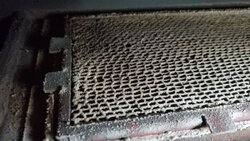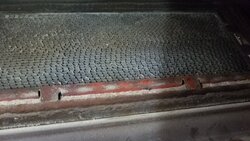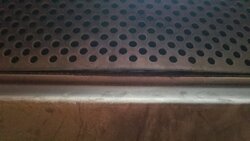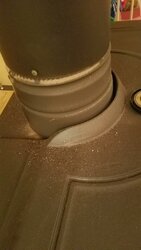Okay, I read every one of your posts, and even a few of the responses. Forgive me if I'm repeating a lot of what was already said, some of that is intentional, but also some is probably because I didn't take the time to read every response already given by every contributor. In any case, some repeat, or even refutation of what has already been said, might be useful at this stage of the game.
It's 19.5ft outside with two 15° elbows to go around the roofline. It's 50°F out and draft seems decent. There is some smoke spillage when it is opened and there are good flames going.
Plus another elbow indoors. Plus another tee on the outside of that wall. Each elbow or tee effectively reduces your chimney height. Old member Backwoods Savage used to always quote the effective height reduction as 2 - 3 feet per 90 degree elbow, which means your original 3' inside + 19.5' outside would be an effective 12.5 feet by his estimate, although I'd bet his numbers are another subject of debate.
Smoke spillage is a definite sign of weak draft in an Ashford 30, the one I have on a 30 foot pipe that never spills an ounce of smoke, no matter when in the burn cycle I open it. The one on the 15 foot pipe rarely spills smoke when I open the door, but it has on a few occasions.
Even now after 6hrs it's still getting some smoke in the house. I had to open a bunch of windows again. I have young kids in the house, I might need to shut it down until it gets colder

Would it help to run it hotter? It was at about 5/10 most of today, now just increased it to 6.
Usually, yes. Draft increases with chimney temperature, and chimney temperature increases with burn rate.
There is about 3' inside and 19.5' outside. It doesn't smell like paint curing, more of a creosote type smell. And I'm pretty positive it is coming from the probe hole...
A few members have reported the same, you are not alone. All but one case of smoke smell have been resolved except one that I am aware. Also all but one were user or installation issues, as far as we know on this forum, I only recall one that was an actual manufacturing issue (incomplete weld leaking creo). The point is, there is a good chance this will be resolved.
Again today, fine when running high, but anything below 7/10 seems to emit some odor. It's now in the 40's. Our 10mo old was coughing all last night. I'm starting to get concerned about the air quality and disappointed overall with this whole endeavor.
Sounds like possibility not a perfect draft and maybe a connector problem? There aren't even any screws connecting the DVL adapter to the stove outlet, just slipped on. Should they have also put some sealant on all the DVL?
At this point, I'd be ordering some equipment to measure the draft. I went with a 0.25"WC Magnehelic off ebay, but there are less expensive options out there.
I just called BK and they said it was definitely a draft issue. The easiest thing would be to add 3ft more chimney to meet the recommended height... should have played it safe during the install.

The temp probe IS directly tapped into the combustor output, so smoke will come out there with poor draft.
Following the timeline of your story, I'd have said the same thing, at this point. Four 90's is an awful lot for 22.5 feet of pipe, when you're aiming for an effective 15 feet.
So update for anyone still reading:
Ordered a 3ft chimney extension and mostly running it full open or 75% a few logs at a time. I tried wrapping a few layers of tinfoil around the probe which seemed to help, but on Sunday I tried a 60% setting with 5 med logs and once it damped down I saw two big puffs of smoke come out of all the dvl connections! Is that normal?
Backpuffing at low burn rates is another indicator of low draft. I used to have the same problem with one of my Jotuls on a 15 foot x 8" clay tile exterior flue. I dropped a 6" liner into that cold clay tile flue, and it was mostly resolved. I moved the stove to the 30 foot flue, and it was completely resolved. We didn't need this to think draft is too low, but this is yet one more indicator.
Luckily it is now staying in the 30's or 20's which should help. How much flue do you need to be able to run medium/low air without getting any smoke in the house? Does anyone have success with a BK wall exit? I'm wondering if my dreams of the 20hr+ are impossible for my setup. Having the window cracked is kind of detracting from the efficiency gained by the BK.
I am doing it on 15 feet of fully insulated liner, straight up. Truth be told, I have had a light creo smell in the house on a few occasions, but that's been the exception. I believe each time has been under one of two conditions:
1. I run the stove on the 15 foot pipe at a very low rate, while having another big air demand in the house, like letting the stove on the 30 foot pipe rip wide open.
2. My house is shaped like a big "U", with a central courtyard, and one stove at either end of the "U". When wind conditions are right, smoke from one chimney can be drawn in as make-up air in windows across the courtyard. Others living in areas prone to downdrafts have reported similar issues, smoke being drawn in from outside, as make-up air. It's possible you are unknowingly resolving this by opening a window near the stove, reducing the need to bring in that make-up air from some location in the smoke path of your chimney, but this seems unlikely if you successfully burned another stove on this chimney.
That sounds pretty similar to my situation. Around the 3:30 is where I'm trying to run overnight. But I get smell everytime. It's always warmed up beforehand for an hour or two on high. Last night I ran at 4:30 setting and there was very little (also 20 degrees out). I don't always have big logs that can last that long. It seems better for me if I warm the flue and then on the overnight load I turn it down earlier and let itself slowly damp the air. If its fully ignited, hot and try to turn down it will smoke hard.
The current supply is 2yr seasoned ash. It was 20% last winter.
I'm wondering if everyone gets this creosote smell at some setting or if that's particular to poor draft setups?
Oddly enough, one guy here (
@aaronk25 ) seemed to be reporting a smell with an unusually high draft. But yes, I suspect others are related to low draft. However, most of us just see our stoves stall out when we try to run too low for our draft, the creo smell issue really has been isolated to just a fraction of the users. It has been mostly Ashford 30 users, though...
Yes, I did search for an interior chimney solution. There is no spot where the pipe can run through without horribly disrupting the rooms. Above this now is the master bed. It would have a very inconvenient position in the room with the pipe running through.
I can easily add more pipe to the top, that is the plan. The downside is that it will have an increasingly awkward appearance to the outside of our modern suburban house. Right now it is sticking up 6' above the roofline on the frontside of the house.
The 90, tee and 15's are definitely limiting the draft. The BK manual calls for 25ft vertical rise with this setup while I'm currently at 22ft. So I'll see how it runs when I return in town next year and add the 3ft.
But you still have the double jog to get around the soffit? It seems the ideal setup would be:
1. Replace indoor 90 with dual 45's.
2. Punch straight thru soffit, get rid of jog up there.
3. Increase height a few feet.
It looks like my "safe" setting is about 4:30 which keeps it about the start of high with a full load. It's enough to last the night but it's a little hotter than needed for nighttime downstairs.
My new chimney pipe came in dent free so I'm hoping that will let me lower the min setting to 3:00 or lower, smoke free.
I run each of mine around 3:00, and my stall points are probably close to 2:00, just for reference. Oddly, the difference between stall point on the two is within minutes on the clock face, very small differences for a two-to-one difference in my two chimney heights.
I'm going to stop here for the night, bed time. I read the rest, so yes... I already know you've added height, and are still having trouble. I'll respond to the rest later.






 My certain someone is completely capable of running ours. It took awhile to get her there!
My certain someone is completely capable of running ours. It took awhile to get her there!


